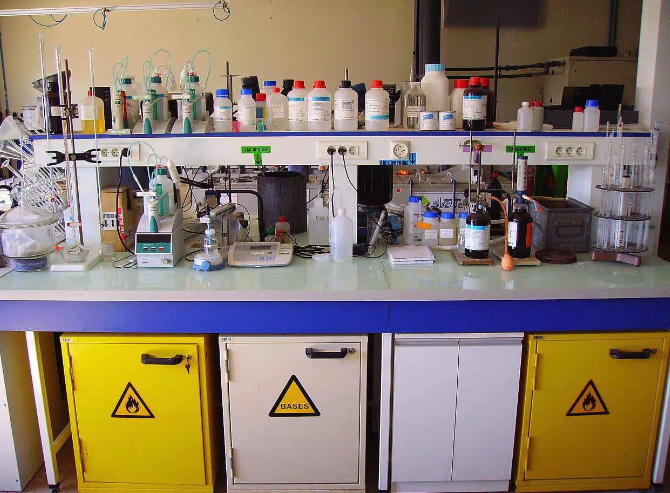Safety training is an essential aspect of any educational institution, often overlooked but crucial in ensuring the well-being of both students and staff. Many people are unaware of the legal requirement for proper safety training when changing grade levels or disciplines, leading to a lack of preparedness in dealing with potential hazards and accidents.
Data analysis from a national study completed in 2020 investigating safety in STEM and CTE laboratories K-12 (Love, T. S., Roy, K. R., & Sirinides, P.).
Key findings include:
- Completing formalized safety training can reduce accidents by 51%, with 77% of accidents involving students and 23% involving teachers.
- Shockingly, 62% of teachers attribute students not following instructions as the leading cause of accidents or injuries, highlighting the need for improved safety protocols and awareness in educational settings.
In addition:
- 80% of science & STEM teachers reported having one injury in the past year
- 51% of schools national have had an injury or litigation
- 35% of teachers of STEM and CTE did not have any formalized safety training
- Completing formalized safety training can reduce accidents by 51%
- Classes with over 24 students were 48% more likely to have an accident occur!
- Teachers with comprehensive safety training were 49% less likely to have an accident occur!
Furthermore, the use of safety equipment in schools is not consistent, with only 45% of schools utilizing properly indirectly vented splash goggles for chemical work. This lack of safety equipment standardization puts students and staff at risk.
The impact of class size on safety is also significant, with steam accidents increasing once class sizes exceed 24 students. Surprisingly, the likelihood of accidents per student rises by 8% when an additional student is introduced into the classroom, emphasizing the importance of maintaining appropriate class sizes to ensure safety.
Chemical inventory management is another concern, as only 41% of schools perform a chemical inventory annually despite it being a legal requirement.
Additionally, 37% of schools lack proper procedures for chemical disposal, posing potential hazards to the environment and individuals within the school community.
In addition:
- 77% of accidents involves students
- 62% of teachers regard students not following instructions as the leading cause of accidents or injuries
- 69% of teachers do not use a safety contract or acknowledgement form with their students
- Only 45% of schools have ANSI/ISEAZ87.1 D3 2020 indirectly vented splash goggles for working with liquids but 83% have safety glasses for students working with solids
- STEAM accidents increase once class size exceeds 24 students. 57% of schools have classes larger than 25 students, but only 26%of those schools have a facility large enough to support that many students
- 41% of schools perform chemical inventory annually
- 37% of schools are unsure how they dispose of chemicals in the district
The consequences of inadequate safety measures and training are evident in the numerous incidents that have occurred in educational institutions, resulting in severe injuries and large lawsuits. These incidents often involve negligence in handling hazardous materials and a lack of safety protocols, putting individuals at risk and causing significant harm.
The statistics also reveal that ninth grade has the highest incidence of accidents, with 70% of lab accidents occurring at this grade level. This emphasizes the need for targeted safety training and preventive measures to address the unique challenges associated with introducing formalized laboratory work to students at this critical transitional stage.
In light of these findings, it is evident that safety training and protocols should be prioritized in educational institutions. This includes implementing consistent safety practices, providing adequate safety equipment, conducting regular safety training for staff and students, and establishing proper chemical management and disposal procedures.
Further Analysis shows that:
- 8 factors correlated with increased accidents occurrences; 17 correlated with deduced accident occurrences.
- Classes with over 24 students were 48% more likely to have an accident occur!
- Teachers with comprehensive safety training were 49% less likely to have an accident!
Furthermore, it is essential for educational institutions to invest in supporting and training new and existing staff, especially those teaching in areas with the highest concentration of accidents. By enhancing safety awareness and preparedness, educational institutions can create a safer environment for learning and minimize the risk of accidents and injuries.
Sources
• Love, T. S., Roy, K. R., & Sirinides, P. (in press). A national safety study examining factors associated with STEM education and CTE accidents in the United States. Safety Science.
• Love, T. S., Sirinides, P., & Roy, K. R. (2022). Examining factors associated with accidents in CTE and STEM education labs: A national safety study. Paper presented at the annual meeting of the American Educational Research Association, San Diego, CA.
Subscribe to edCircuit to stay up to date on all of our shows, podcasts, news, and thought leadership articles.


